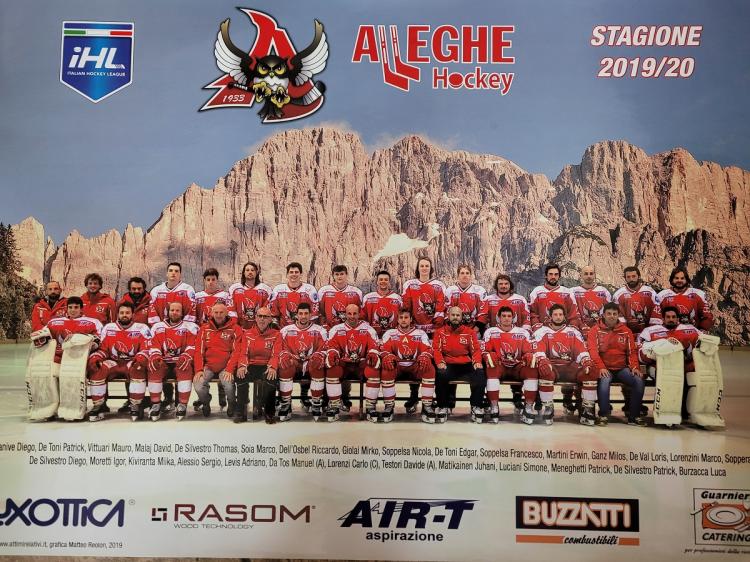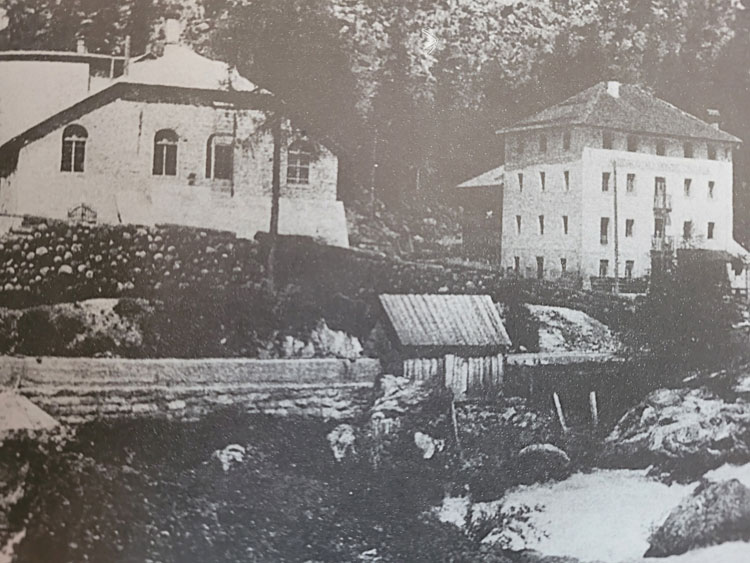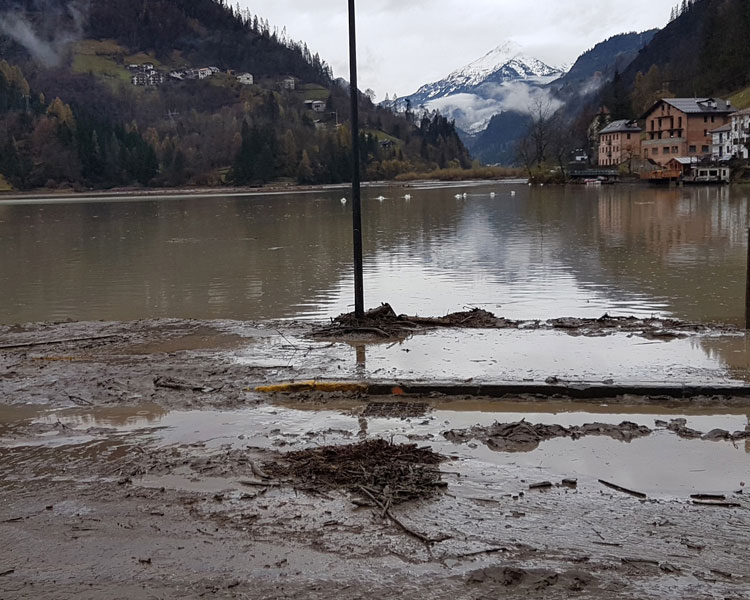Thanks to the precious research work of local historians and to ancient findings, it has been possible to reconstruct the traces of the history of the village from the first settlements in the valley up to the present day, but with a great peculiarity that has strongly characterized Alleghe: the formation of its lake, which has determined in the historical path a very important "before" and "after".
A detailed historical reconstruction can be found in the publications listed at the bottom of the page and available in the town, well summarised on the alleghelago.eu website, where we present the events in chronological order:
The first reconstructible historical part that identifies the first settlements and the orography of the places up to the natural events that led to the formation of the lake is called:
"Alleghe from the origins to the lake".
On the night between 10th and 11th January 1771, an enormous mass of rock, estimated at 10 million cubic metres, slid down from the summit of Monte Piz and shattered at the bottom of the valley, at the height of the present-day village of Masarè, sweeping away and destroying the villages of Riete, Fusine and Marin, among which 49 inhabitants found no escape.
The landslide blocked the course of the torrent and the waters quickly began to rise to a height of 100 m above the river bed, submerging other villages further north. The inhabitants suddenly found themselves divided and isolated from the sheet of water, which at its greatest extent almost reached Caprile. The village of Alleghe, situated further upstream, was saved from the flood, but this was not the end of the story.
On the morning of the first of May a second landslide of 3 million cubic metres detached itself further north than the previous one and plunged into the very recent lake, raising a tsunami wave that reached Alleghe on the opposite bank, in the valley where the Zunaja torrent flows and seriously damaged the church, the rectory and the school of the Battuti causing other victims.
In the following century, with the arrival in the valley of the first explorers and men of letters belonging to the English nobility, regular visitors to the Dolomites, a new and decisive phenomenon began for Alleghe: tourism. Thanks to the process of dissemination carried out by these characters, mountaineers were the first pioneers to visit the valley, especially fascinated by the great north-west wall of the Civetta, which overlooks and is reflected in the calm and crystal clear waters of Lake Alleghe.
The hamlet of Caprile, a borderland between the Habsburg Empire and the Serenissima Republic of Venice, still bears important historical testimony of that period and the development of tourism.
Even the great poet Giosuè Carducci stayed in Caprile in 1886 at the then Albergo Alle Alpi for a period of rest. Today, one of his habitual routes has become a circular theme path dedicated to him and is used by numerous hikers every day.
During the 20th century, the Great War left deep traces in this land with its proximity to the battle lines and the passage of the armies in their respective advances and retreats.
After the Second World War, economic recovery and particularly intense emigration led the population to gradually abandon mountain farming in favour of tourism. In 1966, floods caused great destruction throughout the valley and particularly in Caprile, a village at the confluence of three streams.
Special mention must be made of ice hockey, which since 1932 has accompanied the history of the village with great tradition and popular passion (see box below).

Caprile is located 4 km north of Alleghe and is its main hamlet. It is located at the confluence of three important streams that shape the orography of this valley: the Fiorentina, the Pettorina and the Cordevole, which has its sources at the Pordoi Pass. Its position has characterised its economy in the past; in fact, here were the smelting furnaces, whose bellows could be moved by the energy of the watercourses, which provided for the processing of iron coming from the Fursil mines in the municipality of Colle Santa Luca.
The same location at the confluence of streams has made Caprile subject to flood disasters that have periodically affected its existence. Particularly heavy was that of 1966, when a large part of the village was submerged by water and devastated by debris carried downstream.
A disputed borderland between the Austro-Hungarian Empire and the Serenissima Republic of Venice, it was later one of the first towns where Dolomite tourism developed. At first, English mountaineers, fascinated by the nearby vertical walls, found hospitality in the first accommodation facilities that sprang up in the village. Later, it became a holiday destination for illustrious personalities. One of the most famous was Carducci, who spent a regenerating holiday here and is remembered today by a path dedicated to him.
Particularly noteworthy is the historic centre of the town, where the Column of St Mark stands, erected by the inhabitants in the 17th century to testify their loyalty to the Serenissima and, in particular, to the Venetian Simone Benzoni, author of an important mediation on the disputed territories with the Tyrol.

The tradition of ice hockey in Alleghe began with the establishment of the first sports club back in 1930. Thanks to the presence of the frozen lake in winter, young people of the time tried their hand at the first skates. Some important events were organised on the frozen lake on which the rink for speed skating and the rectangle for hockey took shape.
After the first pioneering years and the interval caused by the war, there was a resumption of activity in the 1946/47 season and the local team began to play its first championships under the name Hocley Club Alleghe. With the arrival of coaches and the first foreign players, there was great ferment in the village around the sport, and the collective enthusiasm with which the team was followed led at the end of 1952 to the decision to move the playing field from the lake to a rink on the mainland built right in the centre of the village where the modern ice palace still stands today.
This period also saw the adoption of the new historical club colours with red and white jerseys on which a large A stands out, making the team unmistakable. The 1966 flood profoundly marked this area and after two years of reconstruction, with the best players having gone to the big city clubs, the team resumed its rise to the Serie A championship.
In 1972, the artificial rink was built, which allowed the ice to be used throughout the year, and it was not until the Universiade of the 84/85 season that the modern roofing of the stadium, now named after Alvise De Toni, was installed.

From the article by Alba Case published in the Alleghe parish bulletin
"LA BIRARIA"
In Masarè, towards the beginning of the 1900s, Paolo De Toni, born in Alleghe on 9 January 1871, built a large brewery building on the boulders and debris of the landslide on Mount Piz. The first beer bottles produced here bore an embossed inscription: SOCIETÀ BIRRERIA MASARÈ, which later became FABBRICA BIRRA ALLEGHE.
For the production of the blond, frothy liquid and also to wash the bottles and for electricity, the Alleghe municipality obtained the concession of a tributary of the Cordevole, the Ru-alt.
The factory was in full activity during the spring and summer. It employed 15-18 workers. In the autumn, the last kota was made, which had to last the whole winter. In the cold season, one or two workers were occasionally left to work: winter demand was logically lower than summer demand.
The beer was put into barrels or glass bottles and transported on two small trucks called 'Americana' and 'Spa', which also had a small trailer, but depending on the case, the horse-drawn cart was also used, which was replaced by the sledge during the winter.
German master brewers were employed for the production of beer. There is precise information about the Austrian master brewer Julius Sefietz, who was here on 13 July 1911 (ANGELINI G. 'Owl on the Streets of the Past', p. 340).
During the war of 15-18, brewing continued from time to time. When the war ended and the men returned home, the activity resumed normally, and indeed improvements were made and the brewery expanded. Taking advantage of the previous experience, the beer improved further and became excellent.

In November 1966, these valleys were also hard hit by the great flood.
Particularly significant damage was recorded in Caprile, which, let us remember, lies at the confluence of three torrents. One of these, the Fiorentina, created a dam that, overwhelmed by the force of the water, burst downstream with great energy, carrying large quantities of materials and timber, invading and submerging the whole of Caprile. Obviously, the other villages including Alleghe also suffered extensive damage. The devastation that followed is well documented by historical photos of the time.
Recently, in 2018, a little more than 50 years after the 1966 flood, a new calamitous event heavily affected the entire valley and its wounds are still clearly visible in the woods and on the valley floor.
It was a hurricane called 'Vaia', which brought not only similar quantities of water to those of 1966, but also a very strong windstorm that tore down houses, felled entire forests, flooded the entire lakeside of the village, destroyed the entire path and cycle path network of the upper Agordino area, which was isolated for a whole week due to the damage to the road network, with no electricity, telephone and internet connections, but fortunately without causing any casualties.